The intersection of foreign aid and EA: a U.S. case study
By ljusten @ 2021-01-08T20:57 (+19)
Key Takeaways
- The U.S. is the largest foreign aid donor giving $45 billion to foreign aid in 2019, but ranked 23rd out of 29 countries in development assistance as a percentage of a country's gross national income.
- Most U.S. aid is distributed to economic development (42%) and humanitarian interventions (14%), but military and security funding makes up a sizable 30% of the foreign aid budget. The majority of U.S. foreign aid is delivered to the Middle East and North Africa, Sub-Saharan Africa, and South and Central Asia with key strategic partners and military commitments like Afghanistan, Israel, and Egypt disproportionately represented.
- The largest barriers to effective U.S. foreign aid spending are power/influence dynamics that encourage large amounts of military aid (although this may be necessary), rigid and sluggish bureaucracy without clear leadership, lack of international coordination, and in-effective on the ground implementation.
- Affecting policy change to make government foreign aid spending more effective would have a very large potential impact. The annual U.S. foreign aid budget is about 1.5 times larger than the annual sum of American giving from individuals, foundations, corporations, and bequests to international affairs.
- Policy change to make U.S. foreign aid more effective seems uniquely achievable because it has broad public and congressional bipartisan support. Narratives that promote foreign aid as a means to national security seem particularly popular.
- Generally I find that this report supports the claim that political reform and better institutional decision making should be elevated in their importance as an EA cause area. Both within the foreign aid policy and more broadly, I think there is a lot more thinking to be done on the role of politics as a catalyst or hindrance of meaningful progress.
Introduction
At university, I’m a physics student who has spent a lot of time working on stuff like deep-learning and climate change research and a lot less on political science. I began this project on foreign aid with the intention of trying my hand at this very different kind of research and providing value to the EA community. I thought that doing a medium-depth profile of U.S. foreign aid would lead to a better understanding of the role that government aid has in doing good as effectively as possible. I’m happy to report that I think both of these intentions proved fruitful: I learned a lot from working on the project and identified several EA relevant implications.
The report is divided into three main sections: an overview of U.S. foreign aid, recommendations to make U.S. foreign aid more effective, and the intersection between Effective Altruism and foreign aid. Although the sections certainly build upon one another, they can be read standalone.
Overview of U.S. foreign aid
What is U.S. foreign aid?
The broadest definition of U.S. aid is given by the Foreign Assistance Act of 1961 in the customary legal jargon. George Ingram at the Brookings Institution provides a good translation: “Foreign aid is money, technical assistance, and commodities that the United States provides to other countries in support of a common interest of the U.S. and that country.” [0][1]. It’s important to note that this definition includes military and security assistance provided––with US national security interests often determining what constitutes a “common interest.”
How much does the U.S. spend on foreign aid?
If you go onto the U.S. Government’s “Foreign Aid Explorer” (explorer.usaid.gov) you will see that in 2019 the U.S. disbursed $45 billion in aid to 215 different countries. However this number reflects the above definition of foreign aid which includes military and security assistance. Another common metric developed by the Development Assistance Committee (DAC) and adopted by organizations like the UN is called Official Development Assistance or ODA and is defined as “government aid that promotes and specifically targets the economic development and welfare of developing countries.” [3]. Notably ODA excludes military aid, anti-terrorism activities, and most peacekeeping expenditures [4]. Under this definition the U.S. contributed only $34.6 billion or 0.16% of their gross national income (GNI) in 2019––costing the U.S. taxpayer under $40 per capita [5][9].
Whether the U.S. definition or the ODA definition is more appropriate largely depends on context. ODA is useful for decoupling U.S. foreign aid from spending based largely on national security interest, but fails to take into account the globally shared benefits––and consequences––from all the funding types it excludes: military aid to allies, anti-terrorism, counter-narcotics, etc.
Historically, U.S. aid levels have fluctuated in response to foreign policy events, but in the last 15 years they have stabilized in the $45-$55 billion range ($28-$35 billion ODA) [5][6]. Aid levels were at their highest following World War II when the U.S. undertook initiatives like the Marshall Plan investing heavily in the rebuilding of Europe and the fight against communism [1][7]. As the Cold War came gradually to an end, aid levels dropped. After the 9/11 attacks, U.S. aid levels (and ODA levels) spiked upwards again driven largely by assistance to Afghanistan and Iraq, President George W. Bush’s global health initiatives like The President’s Emergency Plan for AIDS Relief (PEPFAR), and an increasing emphasis on aid as a U.S. counterterrorism strategy [1][7]. The history of U.S. foreign aid (Figure 1) suggests that aid levels are sensitive to specific domestic and foreign events as well as presidential agendas.
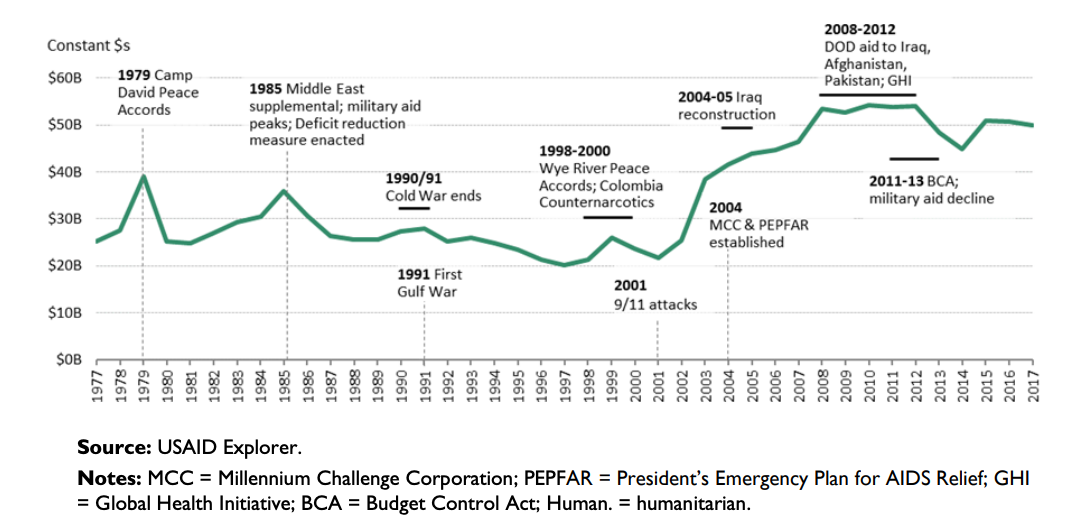
The historical trend in U.S. ODA (Figure 2) look slightly different––in part a reflection of different economic or military responses to crises.
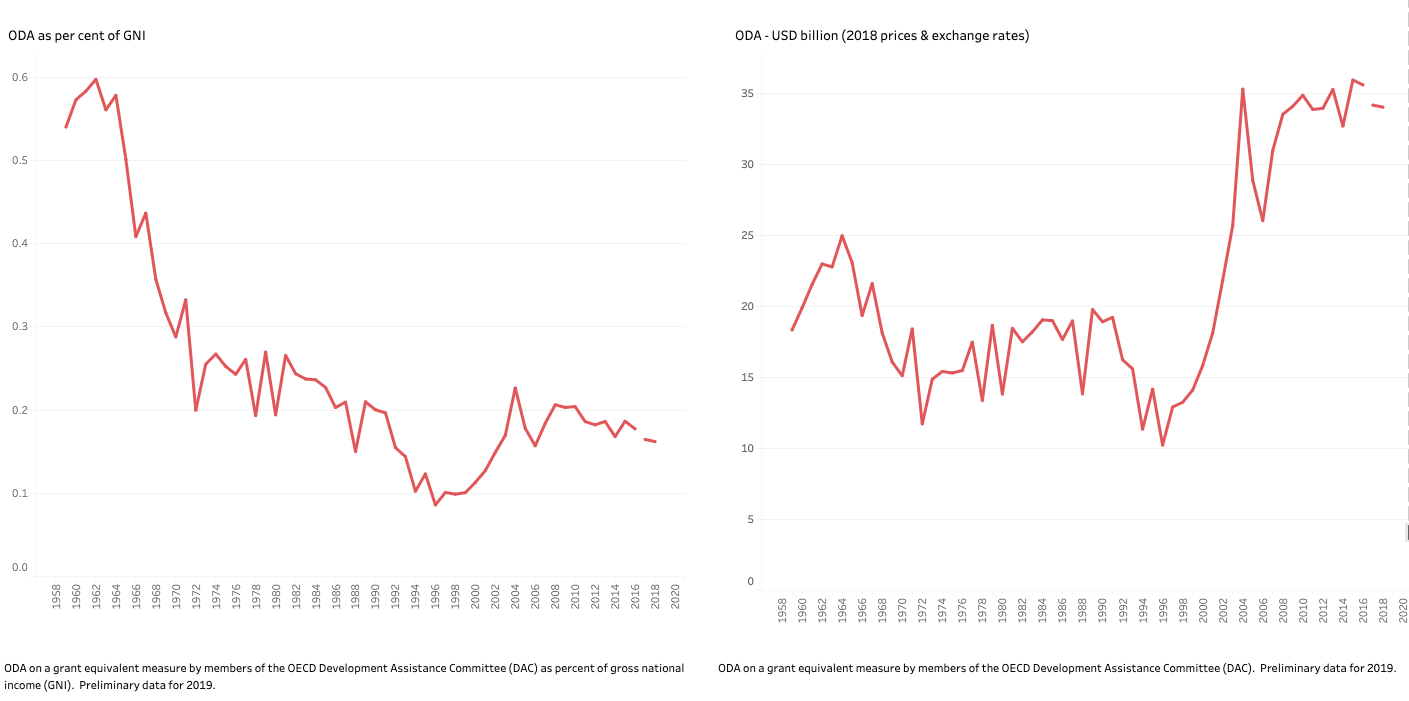
In recent years, U.S. Government foreign aid has been $5-$10 billion more than the sum total of American giving from individuals, foundations, corporations, and bequests to international affairs [8]. Giving USA estimated that in 2019, $28.9 billion out of the total $450 billion of American charitable giving went to international affairs [8]. This value imbalance suggests that increasing the amount and the effectiveness of the U.S. Government’s foreign aid would be one of the most impactful ways to do more good.
How is U.S. foreign aid delivery organized?
Across the U.S. government, a variety of different agencies fund and distribute foreign aid. The U.S. Agency for International Development (USAID) is the largest organizer and distributor of foreign aid among 21 other involved government agencies (Figure 3) [6]. One reason that so many agencies are involved is the multitude of different objectives for foreign aid: military, economic, humanitarian relief, etc [9]. Some federal agencies like the Department of Defense use appropriated funds directly while others transfer funds to different agencies for implementation [1]. For example the State Department and the Department of Agriculture both give funds to USAID for implementation while the Department of Defense implements all the funded military assistance programs itself [1].
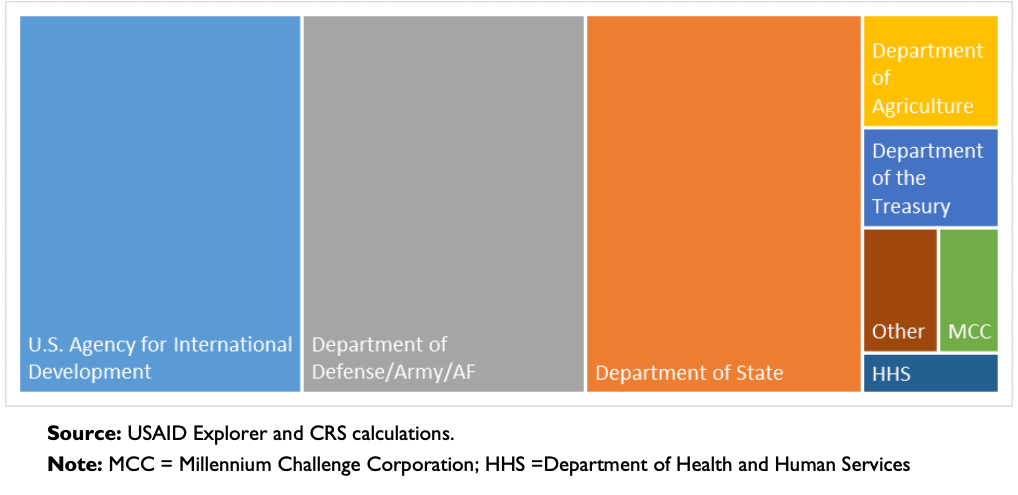
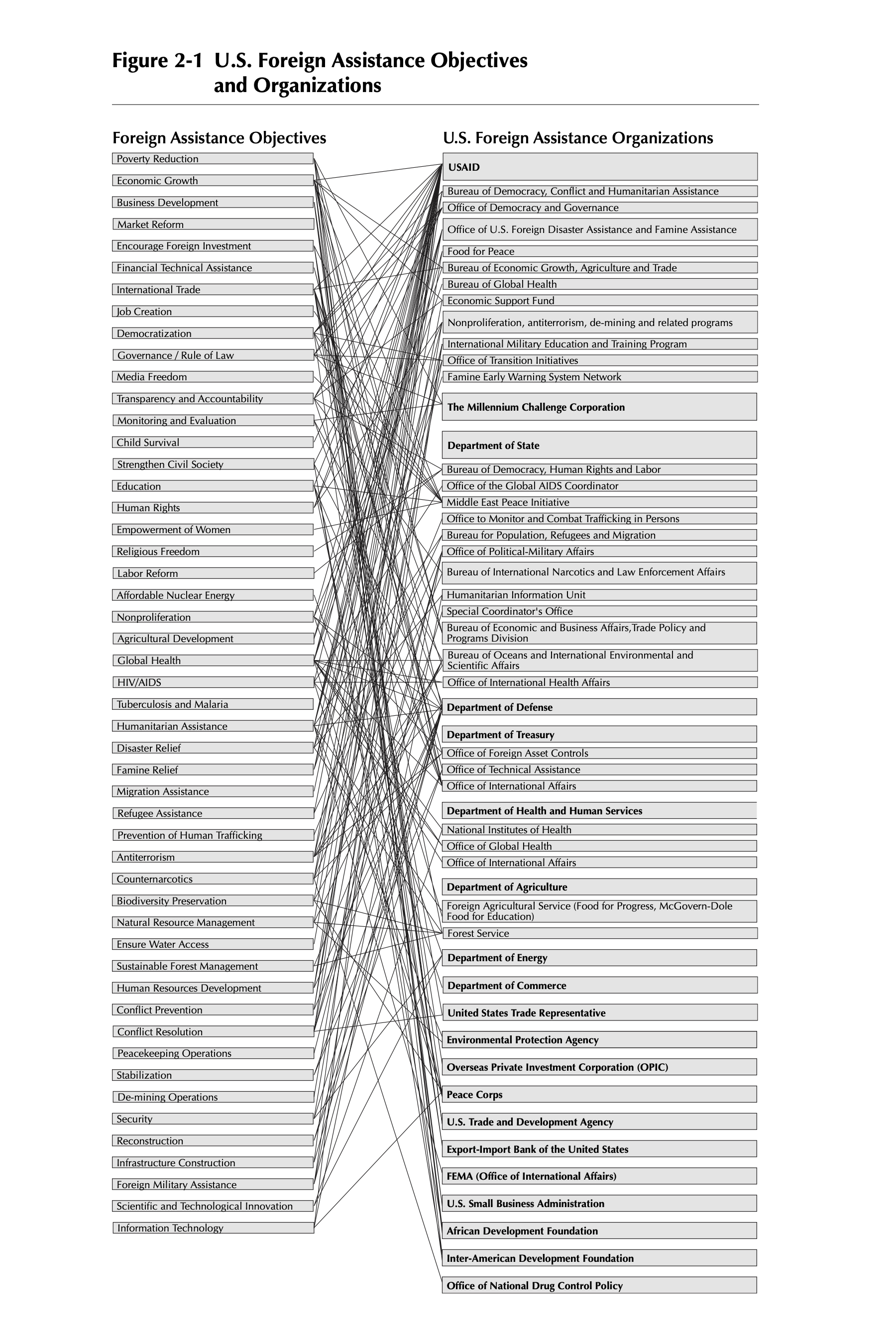
The complex system of U.S. foreign aid funding and distribution has been criticized for its lack of a coherent strategy and objective. In 2016, more than 50 separate units in the U.S. government were involved in aid delivery–– all the signs of a bureaucratic nightmare [9][10]. In a report for the Brooking Institute, Lael Brainard points out “At any given time, in any particular developing country, any or all of over fifty separate government units could be operating separate aid activities with distinct objectives, implementing authorities, reporting requirements, and local points of contact.” [10].
Clearly such a system is not conducive to optimal effectiveness. One reason for the complex web of organizations and objectives is an array of recent presidential foreign aid initiatives with objectives that often overlap those of existing agencies [10]. Fortunately, in the past several years there has been progress to better organize and increase the effectiveness of U.S. assistance: an ongoing restructuring of USAID that began under former administrator Mark Green and the passage of the BUILD act establishing the U.S. International Development Finance Corporation (USIDFC) to give new initiative to U.S. development finance [11][12][13]. Some however argue that a more fundamental organizational overhaul is warranted [10].
Evidence from other countries suggests that the broad restructuring of aid programs along certain key principles is feasible and indeed effective. Almost half the 22 member countries of the Organization for Economic Cooperation and Development (OECD) have undergone major foreign assistance restructuring in the last decade [10][14]. Several reports have outlined key principles and provided concrete recommendations that could guide such an organizational overhaul of U.S. aid programs [10][15][16]. These include rationalizing agencies and clarifying their roles, consolidating leadership into a clear chain of command, grouping responsibility for allocation decisions at the national and local levels under single agencies, focusing on the each agency’s competitive advantage to avoid mission creep and ill-informed decision making, investing in more efficacy and operations research, and elevating the role of development in national security [10].
How is U.S. aid distributed?
U.S. aid is channeled through a variety of programs whose objectives can be categorized and divided in many different ways: most basically as economic or military aid. According to 2019 government figures, $13.4 billion (29.5%) was allocated to military aid and the remaining $32 billion (70.5%) was allocated to economic aid [6]. USAID further classifies aid into more than 20 “sectors,” (see the full list) but they are more concisely summarized in an article from the Council on Foreign Relations (CFR) as: long-term development aid, military and security aid, humanitarian aid, and political aid [7].
Burrowing directly from the CFR article containing 2016 numbers:
Long-term development aid (42 percent) provides ongoing funding for projects to promote broad-based economic growth and general prosperity in the world’s poorest countries. More than half of this goes to bilateral health programs, including treatment of HIV/AIDS, maternal and family health, and support for government health-care systems, mostly in Africa. This also includes funding to multilateral institutions such as the World Bank and the UN Development Program.
Military and security aid (33 percent) primarily goes toward helping allies purchase U.S. military equipment, training foreign military personnel, and funding peacekeeping missions. A smaller slice goes to “non-military security assistance,” which includes counternarcotics programs in Afghanistan, Colombia, Peru, and elsewhere, as well as nonproliferation and counterterrorism efforts.
Humanitarian aid (14 percent) is spent to alleviate short-term humanitarian crises, such as those resulting from famine, earthquakes, war, state failure, or other natural or man-made disasters. This includes State Department and Defense Department disaster relief efforts, as well as purchases of U.S. agricultural goods and funding for organizations such as the International Red Cross and the UN High Commissioner for Refugees.
Political aid (11 percent)
is intended to support political stability, free-market economic reforms, and democratic institutions. Programs include governance and justice system reforms, backing for human rights organizations, and support for peace talks and treaty implementation.
A detailed breakdown of foreign aid programs is visualized by The Washington Post in their “The U.S. foreign aid budget, visualized” article (Figure 5) [17].
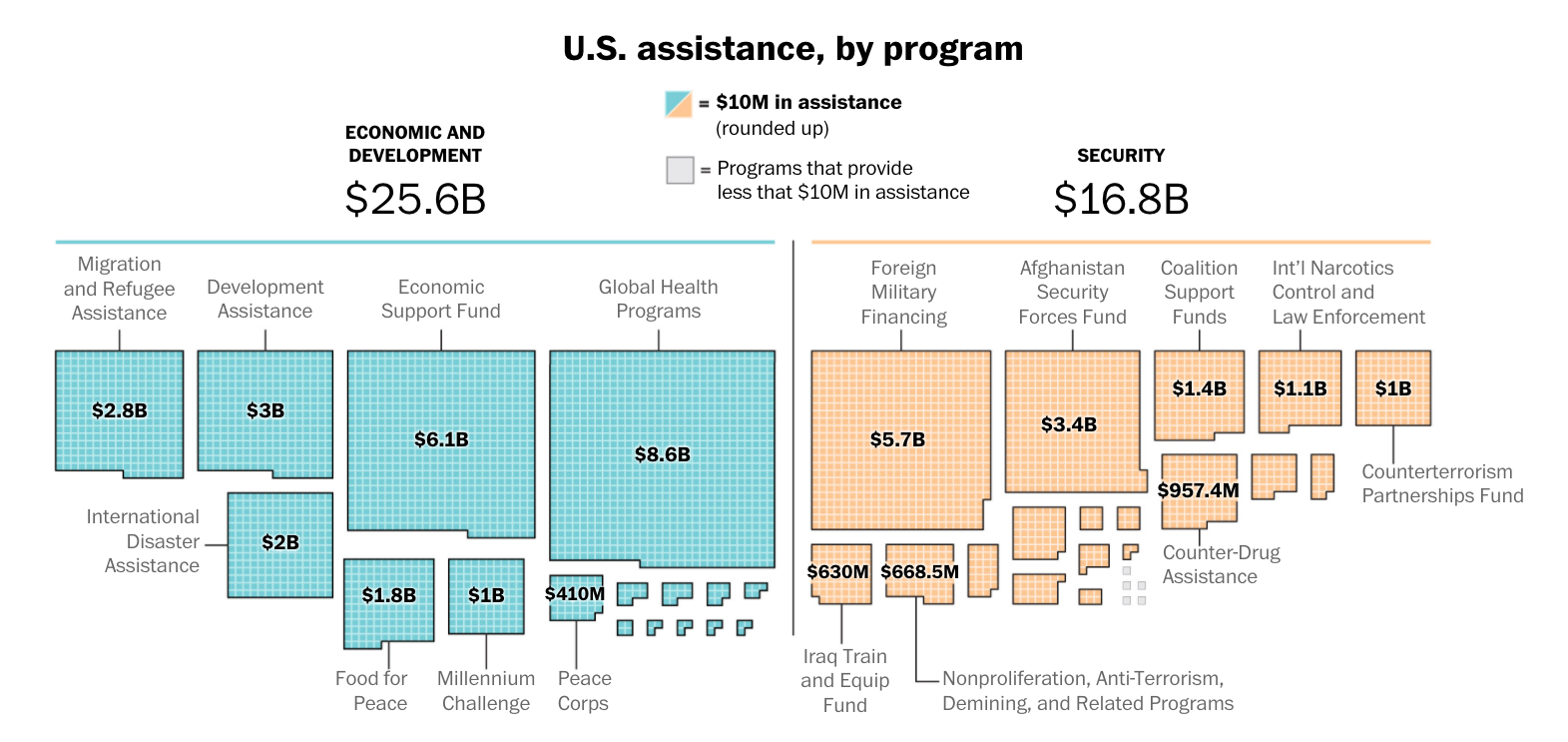
Aid disbursement is also classified by recipient countries. In 2019, 215 countries received U.S. aid with the majority being sent to three regions: Middle East and North Africa ($11 billion), Sub-Saharan Africa ($11 billion), and South and Central Asia ($6.4 billion) [6]. The top five country recipients were [6]:
- Afghanistan ($4.7 billion)
- Israel ($3.3 billion)
- Jordan ($1.6 billion)
- Egypt ($1.5 billion)
- Ethiopia ($875 million)
Many will recognize the top four countries as regional allies or otherwise important for U.S. national security. The concentration of aid in strategically important countries is reflected in the type of funding they are appropriated–– again visualized by the Washington Post [17]. The distribution of military aid and to a more subtle degree economic aid serves key strategic purposes. The delivery of aid is often more focused on the “shared interest” between that country and the U.S. instead of the moral imperative to do the most possible good for as many people as possible. I will return to this alignment issue later when I discuss the efficacy of U.S. aid.
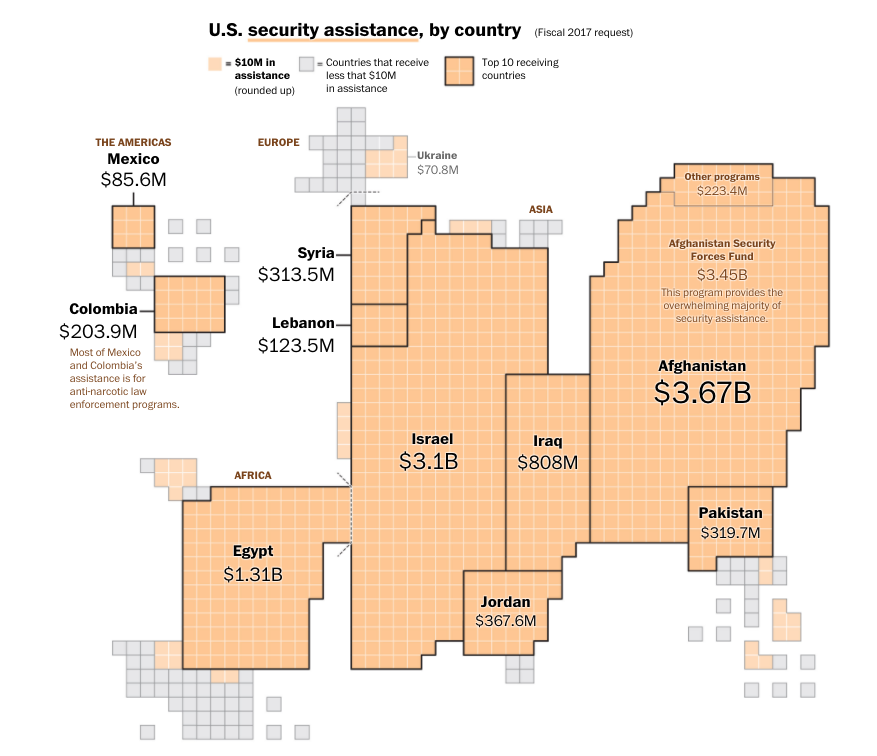
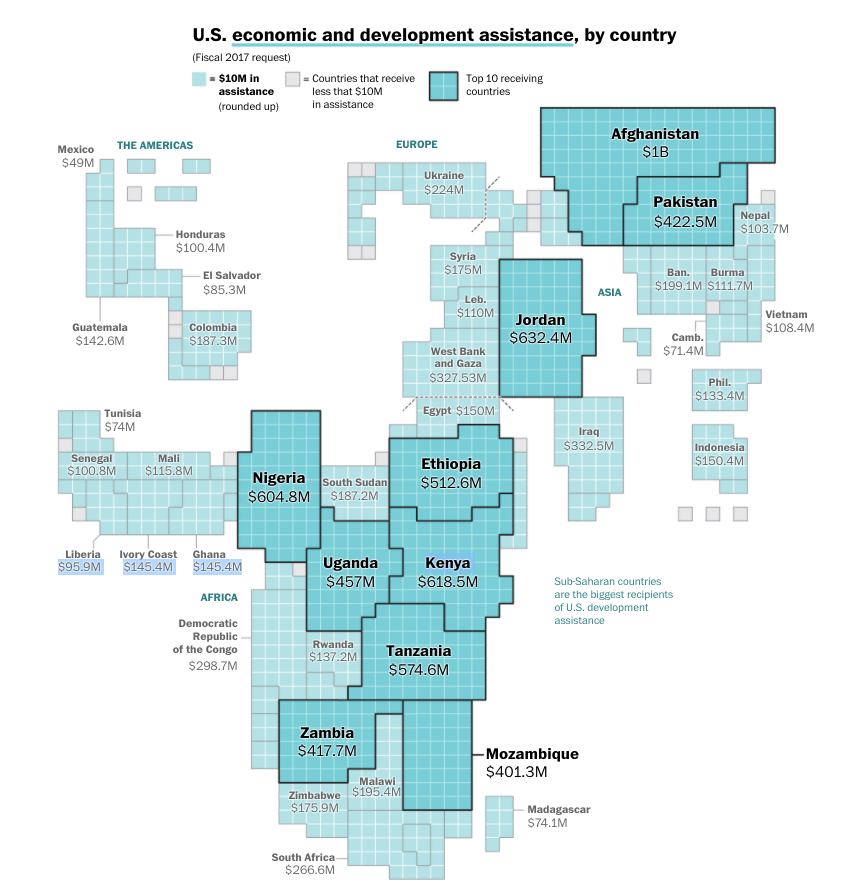
Categorizing aid by recipient country can lead to the misleading conclusion that the U.S. just writes checks to foreign governments who can then do as they please with that money. This is not the case: In 2017 less than 3% of U.S. government aid went directly to foreign governments [2]. Instead, most aid goes to a range of partners including local and international charities, multinational organizations, nonprofits, and other partners in the form of grants [1]. According to the Congressional Research Service “The most common type of U.S. development aid is project-based assistance (77% in FY2017), in which aid is channeled through an implementing partner to complete a project.” [1]. Another 13% of the aid is channeled through international organizations like the UN [1].
By going to the USAID explorer (explorer.usaid.gov) and choosing “By country,” one can see a list of the top partners in each country. For example the top partners in Ethiopia include the World Food Program ($208 million), Catholic Relief Services ($138 million), United Nations Office of the United Nations High Commissioner for Refugees ($74 million), World Vision ($31 million), and Save the Children ($30 million) [6]. Assessing the efficacy of U.S. foreign aid (through an effective altruism lens or otherwise) on a program by program basis is a mammoth task and is not within the scope of this article. Instead I will later focus on broad themes of efficacy.
How does U.S. foreign aid compare to other countries?
Although being the largest single foreign donor country, the United States ranks 23rd in ODA/GNI (official development assistance as a percentage of a country's gross national income) out of the 29 countries that are members of the Organisation for Economic Co-operation and Development’s (OECD) Development Assistance Committee (DAC) [5]. Figure 8 shows both the total ODA by DAC country as well as the ODA/GNI for each country.
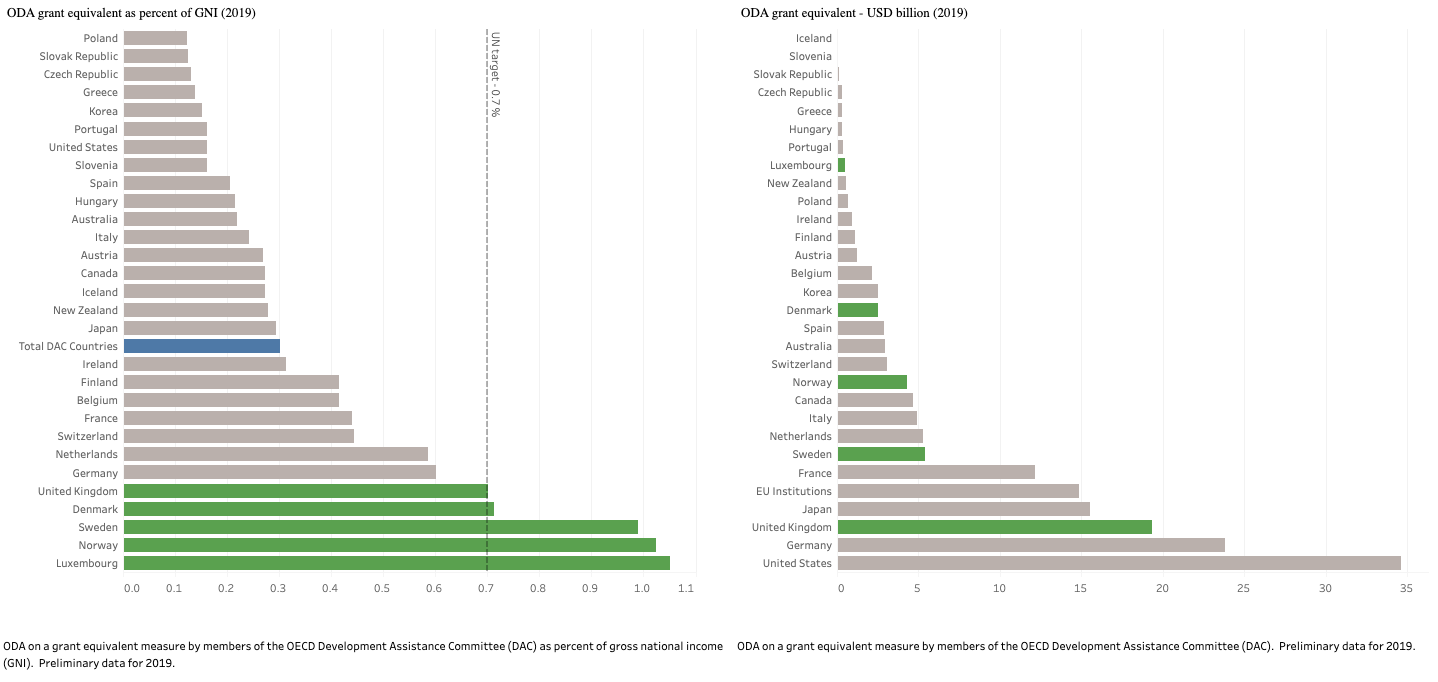
The countries in green represent those meeting the UN target for developed countries to give 0.7% of their gross national income as Official Development Assistance. This goal was established in the Millenium Development Goals declared in 2000 and renewed the 2015 UN Sustainable Development Goals which included a commitment to “reverse the recent decline in ODA to LDCs [and] to encourage ODA of 0.2 per cent of GNI to LDCs” [18]. The U.S. consistently underperforms to this goal all though it's important to recognize that they are still the single largest contributor.
In addition to the poor OECD ranking, the U.S. was ranked just 35th out of 40 in the more comprehensive income-adjusted “Commitment to Development Index 2020” (CDI) [19]. This index created by the Center for Global Development ranks 40 of the world’s most powerful countries by taking into account each country’s performance across seven policy areas: development finance, investment, migration, trade, environment, security, and technology [20]. For a detailed report on U.S. scores on each policy area and concrete recommendations I encourage you to check out the Center for Global Development’s country report. Broadly speaking the U.S. performs well on security and trade and has the most room for improvement on environment, development finance, and technology [21].
The politics of foreign aid in the U.S.
The political history of foreign aid is complex, but surprisingly bipartisan. At first glance, foreign aid spending seems to fit squarely on the democratic side of the aisle, but many republicans also support aid with Republican presidents like Ronald Reagan and George Bush leading some of the most sweeping aid initiatives [0][28]. Even in the military many generals have advocated for more civilian power through foreign assistance. In 2013 then-General Jim Mattis famously testified “If you don’t fund the State Department fully, then I need to buy more ammunition.” [28].
There exist several frequently cited narratives in support of foreign aid:
- Foreign aid as a means of national security
- Foreign aid creates jobs and helps economy like in the Marshall Plan
- Moral leadership
And several against:
- Isolationism “America First”
- Wasteful spending
- The failure of U.S. nation building and world policing
The Trump Administration represented one of the greatest threats to U.S. foreign aid in recent history, yet congress rebuked many of the president's most harmful proposals. Three times the White House prosed large slashes in the foreign aid budget (up to 21% cuts), but none of them passed [30]. In fact during Trump’s presidency, USAID quietly underwent reform praised by many experts as a step towards better organization and efficacy [12][31]. His most lasting damage is from his political messaging that divided the world into friends and foes, attacked multilateral institutions, and pushed the “America first” agenda.
Yet even despite the “America first” rhetoric of Donald Trump, the U.S. public also remains relatively supportive of U.S. foreign aid and international involvement. When polled in 2016, 64% of Americans said the U.S. should take an active role in, rather than stay out of, international affairs [29]. When asked whether the U.S. should participate in efforts to maintain peace, protect human rights, and promote economic development, 69% of republicans agreed [29]. Support for humanitarian aid is even more bipartisan: 81% of Americans said they favor “food and medical assistance to people in needy countries” (73% of Republicans, 90% of Democrats) [29]. However, the broad support for U.S. international involvement conceals other narratives that the U.S. does more than its fair share (55% of Americans; 61% of Republicans) and plays the role of world policeman more than it should (64% of Americans, 61% of Republicans) [29].
The public is also surprisingly ill-informed about how much the U.S. spends on foreign aid. Opinion polls regularly show that Americans believe foreign aid is about 25% of the government’s budget and when asked how much it should be, they say about 10% [0]. Of course in reality foreign aid is less than 1% of the federal budget.
The political and public record suggests that support for foreign aid––in opinion and legislation––is surprisingly robust. At a time when most issues are highly partisan, pushing for foreign aid reform may be one of the more politically feasible interventions.
More resources
“Foreign Aid: An Introduction to U.S. Programs and Policy.” Congressional Research Service, 2019. PDF.
Bearak, Max, and Lazaro Gamio. “Everything You Ever Wanted to Know about the U.S. Foreign Assistance Budget.” The Washington Post, WP Company, 18 Oct. 2018, www.washingtonpost.com/graphics/world/which-countries-get-the-most-foreign-aid/
Recommendations to make U.S. foreign aid more effective
Throughout my research I encountered many recommendations and strategies to increase the effectiveness of U.S. foreign aid and indeed the broader international foreign aid system. Some of the recommendations require major reform of existing institutions that feels near impossible in the current bureaucratic and political landscape, but others are already being enacted or have broad congressional support. I have consolidated the recommendations into six overarching principles: bureaucratic reform and consolidation, better international coordination, a cultural shift from military intervention to foreign aid, more effective aid distribution based on reason and evidence, emphasis on local partners and self-reliance, and allowing more flexibility and risk taking.
It is important to note that although I agree with almost all the recommendations below, I still do have the expertise to endorse them wholeheartedly. Ultimately this section is more of a compilation of expert sources with a few of my own ideas and critiques sprinkled throughout.
Bureaucratic reform and consolidation
Over and over I read how frustratingly complicated and scattered the current U.S. foreign aid system is. There is a desperate need for the consolidation and rationalization of existing agencies under a clear authority and a clear objective. Many suggested that USAID should take on a greater leadership role with full control of its own budget, representation in the presidential cabinet and National Security Council, and increased responsibility for the entire policy, operations, and implementation process. There is also the need for a comprehensive development plan that formulates a clear U.S. strategy and allows for more consistency and predictability of aid.
Allowing more flexibility and risk taking
Congressional earmarks, presidential initiatives, and bureaucratic decision making stifle the flexibility, creativity, and risk taking needed to address complex issues on the ground in developing countries [16][10]. Making sure that foreign aid is spent effectively is a hot political topic since taxpayer money is involved and the american public is allergic to notions of government mismanagement and wasteful spending. But there exists a disconnect between Washington policy making and genuinely effective implementation decisions on the ground. Relaxing “rigid and excessive accountability rules” [16] is an important part of designing and evaluating effective programs that can innovate to meet 21st century challenges.
Incorporating more flexibility into foreign aid spending should also involve broadening the concept of aid beyond assistance like money, food, and training to include trade relationships, policies, and development partnerships.
Comprehensive effectiveness-oriented methodology
The use of data and rigorous effectiveness evaluations is still a new concept in much of the U.S. foreign aid system. Some initiatives like the Millennium Challenge Corporation (MCC) have made great progress in incorporating data, program evaluation, and transparency into their process, but this needs to be adopted across all government foreign aid entities––ideally under a central leadership [16]. The charity evaluator GiveWell provides excellent criteria on which to evaluate aid programs: evidence of effectiveness, cost-effectiveness, room for more funding, and transparency [22]. The distinction between charities and foreign aid programs doesn’t seem to be particularly important here; although one might want to add criteria relating to national security interests when appropriate.
Emphasis on self-reliance and local partnerships
Throughout the years the autonomy of field programs has fluctuated with a trend towards central control in the 2000s [16]. Programs have often been designed around U.S. policy priorities in Washington instead of the needs of the indigenous people––sometimes for legitimate reasons. There are challenges in the decentralization of the decision making process to local partners: accountability, consistent data collection, difference in norms and values, or corruption. There are also situations where specific development problems have tried-and-tested solutions that can be effectively performed by government entities. Overall however there seems to be a consensus that if effectiveness and long-term impact are to be the goal then the balance of decision-making power needs to be shifted towards local partners and local priorities to find “best fit” solutions to the unique challenges faced. This shift is further encouraged by the increasing emphasis on self-reliance.
Self reliance means “reliance on one's own powers and resources rather than those of others.” It’s a very politically appealing message in America, and some, including USAID argue that it has developmental merits. By supporting local partners in addressing the needs of their country they can become sustainable well-run organizations that can ultimately become self-reliant–– at least that is the idea [16][26]. I’m unsure on what timescale the self-reliance principle is intended to work, but after seeing a similar approach largely fail in Afghanistan (the U.S. military spent enormous resources to make the Afghan government self-reliant) I’m skeptical towards this kind of messaging. I imagine that notions of self-reliance in many LDCs will require patience.
International coordination
International organizations like the United Nations and the Global Partnership for Effective Development Co-operation (GPEDC) have increasingly been advocating for more coordination on global development. Lack of coordination by individual donor countries can result in aid fragmentation: a process where “aid comes in too many small slices from too many donors, creating high transaction costs and making it difficult for partner countries to effectively manage their own development.” [23]. Another challenge is the uneven distribution of aid and donor partners to create “aid orphans” who receive very little help and “aid darlings” who soak up lots of aid [24].
From an international perspective, there are several recommended strategies to better coordinate aid. The entire international community should both increase the transparency and predictability of donor’s forward intentions and increase joint planning and programming for aid distribution. Additionally countries should consider increasing their share of multilateral aid for more rational overall allocation of aid resources.
On a national scale, the U.S. should take a leadership role in effort to coordinate aid and encourage higher levels of foreign aid spending. This starts with signing on to key treaties like the Busan Partnership that outlines principles for effective development aid and increasing the U.S. foreign aid budget to be in line with the 0.7% ODA/GNI standard set by the UN [25].
Cultural shift
In a lot of my research I heard two different but sometimes overlapping interpretations of foreign aid. Some rightly argued that foreign aid from wealthy countries to the least developed countries is a moral imperative to help alleviate the suffering of others. But often the argument was more realist in nature with an interpretation of foreign aid as a political tool for leverage and influence. In practice, it’s this latter view that seems most prevalent in aid allocation and distribution. The delivery of military aid to key strategic allies and the increasingly popular view of development as a form of national security are two examples of this. The new U.S. International Development Finance Corporation (USIDFC) is a direct response to the growing international influence of China through channels like the Belt and Road Initiative [13].
I think it is safe to say that the U.S. should more heavily weigh the moral significance of foreign aid and invest appropriately (EA causes could certainly be more represented), but I’m also sympathetic to the realist view of aid. I believe it is important for the U.S. to counter Chinese influence abroad, assist strategic allies, and fund counter-terrorism and peace-keeping missions even though these don’t fit cleanly into some of the more idealistic arguments about helping people and doing good. However I think that even a realist view of foreign aid should involve a U.S. transition from heavily military based aid to more strategic economic and development aid [16].
I remain unsure how to even think about balancing the reality of global power and influence with other causes like humanitarian help and development.
More resources
Ingram, George. “Aid Effectiveness: Reform in the new administration and congress.” Global Economy and Development, 2016. PDF.
Brainard, Lael. “Organizing foreign assistance to meet twenty-first century challenges.” Security By Other Means, 2016. PDF.
Thioléron, Elisabeth. “Managing aid: practices of DAC member countries.” Organisation for Economic Co-operation and Development, 2009. PDF.
“Official Development Assistance.” Inter-Agency Task Force for Development, 2016. PDF.
“Redesign Consensus: A plan for U.S. Assistance.” 2017. PDF.
“Making development co-operation more effective.” Global Partnership for Effective Development Co-operation, 2020. PDF.
U.S. foreign aid and Effective Altruism
I began this project partly to clarify the different roles of government aid and charity–– and to some degree I have not found a satisfying answer. Yet I believe that this project has yielded useful insights into the large potential impact of reforming foreign aid programs and the importance of policy and institutional decision making as cause areas.
The difference between foreign aid and philanthropic aid
It is difficult to compare foreign aid directly to charity spending. As I have discussed it, U.S. foreign aid is a budget: a sum of money allocated for the purpose of supporting foreign countries with a shared interest–– moral or strategic. To my knowledge there is not an equivalent concept in the philanthropic world because charities and foundations are funded by private individuals and operate on entirely different incentives. I’ll define the concept philanthropic aid as:
- the sum total of money and commodities contributed by individuals, foundations, corporations, and bequests to international affairs that is managed by charitable organizations within a political unit or organization over a set period of time.
The philanthropic budget operates on some very different market principles and rationals than the foreign aid budget that should probably get spelled out further (a later project), but I think the concept is useful to examine some key differences between the two.
- The size of the U.S. foreign aid budget is about $16 billion––a factor of 1.5––greater than the U.S. philanthropic budget as reported by Giving USA. The U.S. Agency for International Development (USAID) is solely responsible for an annual budget of more than $21 billion. For comparison, the Gates Foundation currently has an annual endowment of $2.7 billion and the entire UN will cost just over $3 billion to fund in 2021.
- Foreign aid is currently crucial to cover the most large scale, logistically challenging, and very expensive problems like massive humanitarian assistance in the wake of natural disasters and economic development in LDCs. Although many U.S. foreign assistance initiatives are performed by local partners and charities, it's the billions of dollars delivered to groups like the World Food Bank and the United Nations that seem most reliant on government aid.
- Governments have unique access to more in-depth and potentially more impactful partnerships with recipient countries and other donor countries than typical charities do––although this is not always exploited.
- Development aid that focuses on strengthening the infrastructure and economies of less developed countries seems largely unique to government foreign aid spending.
- Foreign aid disbursement is guided by policy choices that reflect national interests to greater degree than moral responsibility. If true, I am unsure how to reconcile this with the goal of doing the most possible good. Having an influential and powerful United States seems like an important thing for world progress, but this requires some self-serving foreign aid goals. Directing funding strategic allies like Egypt to promote stability in the Middle East and North Africa despite a less than stellar human rights record is one such confusing example.
What are my takeaways from this project?
Advocate for more U.S. foreign aid funding and effectiveness: Given the amount of money involved, implementing policy to spend foreign aid more effectively could have a massive impact. Policy change on foreign aid spending seems at least somewhat feasible given bipartisan and public support. Some organizations like GiveWell that have begun to examine philanthropic funding in politics may want to consider doing more work in this area. The criteria and methodology developed by charity evaluators in the EA community would also be well suited to evaluate the effectiveness of foreign aid programs.
Increase the representation of EA cause areas in foreign aid spending: Some EA cause areas like nuclear security and biosecurity could be funded and coordinated by U.S. foreign aid. For example, USAID already funds programs in Russia to prevent radioactive materials from being used in acts of terrorism [27]. Directing foreign aid funds to multilateral initiatives to reduce nuclear risk and biorisk seems politically feasible.
Elevate the importance of better institutional decision making as an EA cause area: I believe that this report supports the claim that political reform and better institutional decision making should be elevated in their importance as a cause area. The potential impact of directing government funds and making the aid system more efficient would be massive and are evidence of the influence wielded by governments. Both within the foreign aid policy and more broadly, I think there is a lot more thinking to be done on the role of politics as a catalyst or hindrance of meaningful progress.
Examine the consequences of increasing coordination between charities or donors: In the reports I read, more coordination on global development and aid was a frequently cited goal to avoid inefficiencies and the unequal distribution of assistance. One UN report suggested that countries should consider increasing the share of multilateral aid to “contribute to a more ‘rational’ overall allocation of aid resources.” [18]. Based on the foreign policy recommendations for nations, are there strong arguments for designating an increased share of donations to coordinated funds like GiveWell’s Maximum Impact Fund and the various CEA funds?
References
[1] https://fas.org/sgp/crs/row/R40213.pdf
[2] https://www.concernusa.org/story/foreign-aid-explained/
[6] https://explorer.usaid.gov/aid-trends.html
[7] https://www.cfr.org/backgrounder/how-does-us-spend-its-foreign-aid
[9] https://www.brookings.edu/wp-content/uploads/2016/06/20040731aspen.pdf
[10] https://www.brookings.edu/wp-content/uploads/2016/07/securitybyothermeans_chapter.pdf
[11] https://www.brookings.edu/blog/up-front/2018/04/18/a-first-look-at-usaids-redesign-plan/
[12] https://www.devex.com/news/what-mark-green-hopes-to-leave-behind-at-usaid-96983
[13] https://www.csis.org/analysis/build-act-has-passed-whats-next
[14] https://www.oecd.org/dac/peer-reviews/35051857.pdf
[15] http://modernizeaid.net/wp-content/uploads/2017/10/Redesign-Consensus-Plan-for-U.S.-Assistance.pdf
[16] https://www.brookings.edu/wp-content/uploads/2016/11/global_111716_aid-effectiveness.pdf
[17] https://www.washingtonpost.com/graphics/world/which-countries-get-the-most-foreign-aid/
[18] https://www.un.org/esa/ffd/wp-content/uploads/2016/01/ODA_OECD-FfDO_IATF-Issue-Brief.pdf
[19] https://www.cgdev.org/cdi#/?adjusted=true
[20] https://www.cgdev.org/publication/commitment-development-index-2020
[21] https://www.cgdev.org/cdi#/country-report/united_states
[22] https://www.givewell.org/how-we-work/criteria#Criteria
[24] http://www.oecd.org/dac/financing-sustainable-development/fragmentation-orphans.htm
[25] https://www.effectivecooperation.org/landing-page/about-partnership
[26] https://www.usaid.gov/selfreliance
[27] https://explorer.usaid.gov/cd/RUS
[28] https://www.brookings.edu/research/the-politics-of-foreign-aid/
[29] https://www.brookings.edu/research/american-public-support-for-foreign-aid-in-the-age-of-trump/
[30] https://www.devex.com/news/disrupt-and-compete-how-trump-changed-us-foreign-aid-97955
Tony.Sena @ 2021-01-11T16:09 (+2)
This was a great summary of US foreign aid. I appreciate the research that went into this to synthesize deeply yet succinctly the key features of the system. I recently read Prof Angus Deaton's book, 'The Great Escape' in which he argues against broad based foreign aid, especially in the form that is described in this piece. I key element of his argument (as I understood it) is that there is a correlation between countries that receive aid and countries that depend on aid. Prof Deaton goes on to argue that those countries that are receiving aid are the ones that are actually negatively impacted by receiving aid due to corruption, poor administration, institutional challenges etc. Furthermore, Prof Deaton goes on to argue that how aid is provided will only perpetuate these issues in receiving countries.
Given these challenges, I would be interested in your views on the very premise of foreign aid as an effective use of resources.
ljusten @ 2021-01-14T00:44 (+2)
Hi Tony. I just released a second post Is Foreign Aid Effective? where I share a review of aid effectiveness literature. Overall I think that yes aid is an effective mechanism to do good in the world. Important functions like food security and humanitarian relief are almost entirely dependent on foreign aid and are definitely "effective."
Of course the effectiveness of aid is still far from ideal. There lot of examples in which foreign aid projects had no impact or even a negative impact on the recipient countries. Much like we have discovered with charities, effectiveness often varies at orders of magnitude. I imagine foreign aid programs are similar. Foreign aid also hasn't produced much measurable economic growth in poor countries for reasons which I highlight in my second post.
I think there is also reasons for optimism regarding trends in foreign aid. There seems to be a significant shift among countries to implement more randomized control trials and generally be more transparent.The transformation of USAID is a good example a positive step towards more effective foreign aid.
jared_m @ 2021-01-09T22:18 (+2)
One organization that diligently pressures U.S. presidential candidates to commit to greater foreign aid investments — with a focus on Iowa, N.H., and other key early presidential primary and caucus states — is Bono's ONE Campaign. Here are two backup links showing their work in:
- 2015 organizing for the 2016 U.S. presidential cycle
- 2019 organizing for the 2020 U.S. presidential cycle
If interesting as a case study / food for thought. The 2019 article begins:
Foreign aid is often used more in political campaigns as a punching bag than as an applause line, but more Iowans may be pressing their candidates and elected officials on the subject if the ONE campaign is successful here.
ONE, a non-partisan advocacy organization co-founded by Bono, works to end extreme poverty and preventable diseases, particularly in Africa. They’re currently running a grassroots campaign in Iowa to get voters to contact their senators and urge them to support the Global Fund and to maintain America’s leadership in the global AIDS fight.
They have volunteers in Des Moines, Iowa City and Waverly, and are in the process of launching chapters at Drake University and Iowa State University. ONE will be present at the 80/35 music festival, as well as the Drake Global Health Consortium to connect and build a larger network of volunteers to reach out to senators.
“Over 700 million people are still living on less than $1.90 a day, over half of them in sub-Saharan Africa. This is an injustice with far-reaching consequences,” Sean Simons, press secretary for the ONE campaign, told Starting Line.
ljusten @ 2021-01-14T00:48 (+1)
Yea that is very interesting. Foreign aid is definitely not a super important issue for voters in the U.S. but it is surprisingly bipartisan. I think even those with more hawkish or isolationist messages recognize for the importance of foreign aid for national security.
Increasing public awareness on foreign aid spending could definitely help incentivize more reform. I applaud the efforts by the ONE campaign.